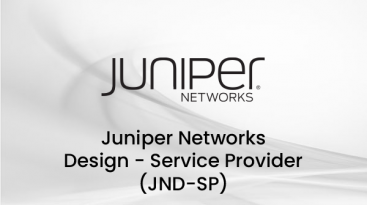Overview
This course is designed to cover best practices, theory, and design principles for Wide Area Network (WAN) design including WAN interconnects, security considerations, virtualization, and management/operations. This course covers both service provider and enterprise WAN design.
Duration 5 days.
You can find current trainings on training calendar page.
Training Prerequisites
- Knowledge of routing and switching architectures and protocols.
- Knowledge of Juniper Networks products and solutions.
- Understanding of infrastructure security principles.
- Completion of the Juniper Networks Design Fundamentals (JNDF) course.
Training Contents
Course Introduction
Overview of WAN Design
- WAN Design Overview
- WAN Domains
- Management, Operations, and Security
- Implementation Considerations
WAN Connectivity
- Public and Private
- Service Provider
- Enterprise
Network Availability and Traffic Prioritization
- Network Availability
- Class of Service
Service Provider Core WAN
- WAN Core Overview
- Core Routing
- MPLS Design
- CoS Considerations
Service Provider Edge WAN
- Provider Edge
- Lab: Service Provider Edge—VPN Design
- Access and Aggregation Edge
- Services
- CoS Considerations
- Multicast
Enterprise WAN
- Enterprise WAN Overview
- WAN Topologies
- Campus and Branch
- CoS Considerations
- Large Enterprise Designs
Data Center WAN
- WAN Overview
- EVPN
WAN Security
- Security Overview
- WAN Versus LAN
- Service Provider Core WAN Security
- Service Provider Edge WAN Security
- Enterprise WAN Security
WAN Management
- Best Practices and Considerations
- OoB Management Design
- Junos Space
- Juniper WAN Automation
WAN Virtualization and SDN
- SDN Overview
- NorthStar
- Contrail
- SD-WAN
WAN Device Portfolio
- Platform and Junos Overview
- MX Series
- SRX Series
- PTX and T Series
- ACX Series
- QFX Series
- EX Series
- NFX Series
Training Objectives
- Describe high level concepts about the different WAN architectures.
- Identify key features used to interconnect WANs.
- Describe key high level considerations about securing and monitoring a WAN deployment.
- Outline high level concepts for implementing WANs.
- Explain various methods of WAN connectivity.
- Describe basic MPLS concepts as they are related to WANs.
- Identify basic Ethernet concepts as they are related to WANs.
- Describe key concepts of network availability.
- Explain high availability features and protocols.
- Describe the key aspects of class of service.
- Describe how core WAN technologies are used to solve specific problems facing network designers.
- Discuss core routing requirements.
- Explain how to design a high performance MPLS WAN core.
- Define CoS requirements for the WAN core.
- Discuss BGP peering and path selection.
- Design MPLS Layer 2 and Layer 3 services.
- Design metro Ethernet networks.
- Understand role of class of service in provider edge.
- Describe Next-generation MVPNs.
- Explain how enterprise WAN technologies are used to solve specific problems facing network designers.
- Outline various solutions regarding campus and branch WANs.
- Explain how data centers are interconnected through WANs.
- Identify various solutions regarding data center WAN interconnection.
- Describe the benefits and use cases for EVPN.
- Describe security concepts regarding WANs.
- Explain the differences between LAN security concepts and WAN security concepts.
- Explain VPN-related concepts regarding WANs.
- Describe methods to manage WANs.
- Discuss key concepts related to WAN management.
- Explain how virtualization and SDN can be leveraged in the WAN.
- Describe various SDN products and how they are used in the WAN.
- Describe MX, SRX, T, PTX, ACX, QFX, EX, and NFX Series devices and the basics of how they relate to WAN solutions
Who should attend?
This course is targeted specifically for those who have a solid understanding of operation and configuration and are looking to enhance their skill sets by learning the principles of WAN design.
- Overview
- Prerequisites
- Contents
- Objectives
- Audience
Overview
This course is designed to cover best practices, theory, and design principles for Wide Area Network (WAN) design including WAN interconnects, security considerations, virtualization, and management/operations. This course covers both service provider and enterprise WAN design.
Duration 5 days.
You can find current trainings on training calendar page.
Training Prerequisites
- Knowledge of routing and switching architectures and protocols.
- Knowledge of Juniper Networks products and solutions.
- Understanding of infrastructure security principles.
- Completion of the Juniper Networks Design Fundamentals (JNDF) course.
Training Contents
Course Introduction
Overview of WAN Design
- WAN Design Overview
- WAN Domains
- Management, Operations, and Security
- Implementation Considerations
WAN Connectivity
- Public and Private
- Service Provider
- Enterprise
Network Availability and Traffic Prioritization
- Network Availability
- Class of Service
Service Provider Core WAN
- WAN Core Overview
- Core Routing
- MPLS Design
- CoS Considerations
Service Provider Edge WAN
- Provider Edge
- Lab: Service Provider Edge—VPN Design
- Access and Aggregation Edge
- Services
- CoS Considerations
- Multicast
Enterprise WAN
- Enterprise WAN Overview
- WAN Topologies
- Campus and Branch
- CoS Considerations
- Large Enterprise Designs
Data Center WAN
- WAN Overview
- EVPN
WAN Security
- Security Overview
- WAN Versus LAN
- Service Provider Core WAN Security
- Service Provider Edge WAN Security
- Enterprise WAN Security
WAN Management
- Best Practices and Considerations
- OoB Management Design
- Junos Space
- Juniper WAN Automation
WAN Virtualization and SDN
- SDN Overview
- NorthStar
- Contrail
- SD-WAN
WAN Device Portfolio
- Platform and Junos Overview
- MX Series
- SRX Series
- PTX and T Series
- ACX Series
- QFX Series
- EX Series
- NFX Series
Training Objectives
- Describe high level concepts about the different WAN architectures.
- Identify key features used to interconnect WANs.
- Describe key high level considerations about securing and monitoring a WAN deployment.
- Outline high level concepts for implementing WANs.
- Explain various methods of WAN connectivity.
- Describe basic MPLS concepts as they are related to WANs.
- Identify basic Ethernet concepts as they are related to WANs.
- Describe key concepts of network availability.
- Explain high availability features and protocols.
- Describe the key aspects of class of service.
- Describe how core WAN technologies are used to solve specific problems facing network designers.
- Discuss core routing requirements.
- Explain how to design a high performance MPLS WAN core.
- Define CoS requirements for the WAN core.
- Discuss BGP peering and path selection.
- Design MPLS Layer 2 and Layer 3 services.
- Design metro Ethernet networks.
- Understand role of class of service in provider edge.
- Describe Next-generation MVPNs.
- Explain how enterprise WAN technologies are used to solve specific problems facing network designers.
- Outline various solutions regarding campus and branch WANs.
- Explain how data centers are interconnected through WANs.
- Identify various solutions regarding data center WAN interconnection.
- Describe the benefits and use cases for EVPN.
- Describe security concepts regarding WANs.
- Explain the differences between LAN security concepts and WAN security concepts.
- Explain VPN-related concepts regarding WANs.
- Describe methods to manage WANs.
- Discuss key concepts related to WAN management.
- Explain how virtualization and SDN can be leveraged in the WAN.
- Describe various SDN products and how they are used in the WAN.
- Describe MX, SRX, T, PTX, ACX, QFX, EX, and NFX Series devices and the basics of how they relate to WAN solutions
Who should attend?
This course is targeted specifically for those who have a solid understanding of operation and configuration and are looking to enhance their skill sets by learning the principles of WAN design.





